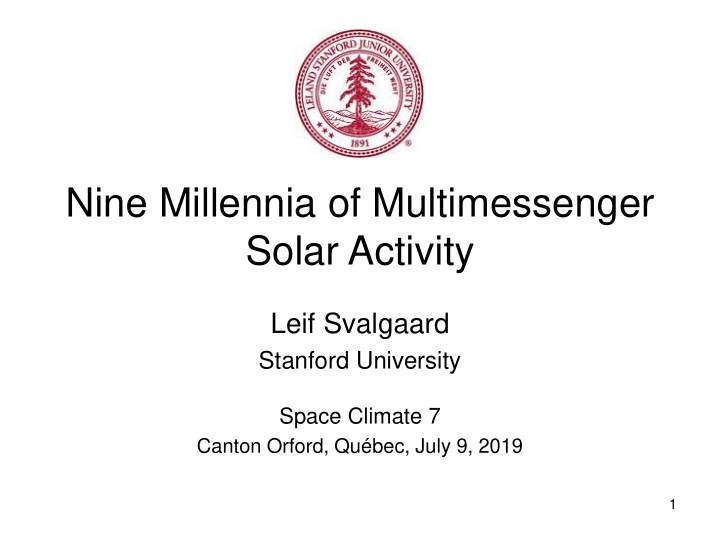



Nine Millennia of Multimessenger Solar Activity Leif Svalgaard Stanford University Space Climate 7 Canton Orford, Québec, July 9, 2019 1
The Many Messengers of Solar Activity Faraday wrote to R. Wolf on 27th August, 1852: “I am greatly obliged and delighted by your kindness in speaking to me of your most remarkable enquiry, regarding the relation existing between the condition of the Sun and the condition of the Earths magnetism . The discovery of periods and the observation of their accordance in different parts of the great system, of which we make a portion , seem to be one of the most promising methods of touching the great subject of terrestrial magnetism... 2 Which we today can extend to solar (system) activity as well
The Cosmogenic Record Wu et al. (Wu, C. J., Usoskin I. G., Krivova, N., et al. 2018, A&A , 615 , A93) present a multi-proxy reconstruction of solar activity over the last 9000 years, using all available long-span datasets of the radioactive 10 Be and 14 C messengers in terrestrial archives. These cosmogenic isotopes are produced by cosmic rays in the Earth’s atmosphere and their measured production/depositional flux reflects changes in the cosmic ray flux in the past and depends on solar magnetic activity and on the variation of the Earth’s magnetic field and even on the climate (atmospheric circulation). The effect is expressed by the so-called modulation potential (cosmic ray energy spectrum). 3
Reconstructed Sunspot Number V1 Messenger 1: The modulation potential is not very useful as a solar activity proxy since it is model dependent. So Wu et al. reconstructed the sunspot number (SN) instead (confidence interval shown by gray shading). The red line depicts the decadal average resampled SN (version 2, scaled down by 0.6 to make it version-1-like because the reconstruction was based on the ‘Open Flux’ derived from version 1). 4 The red line doesn’t quite fit: a bit (~20%) too high
Converting Wu ‘V1’ to V2 Decadal Averages 1705-1885 Wu et al. claim that one can convert their version 1 reconstruction to version 2 by multiplying by 1/0.6 = 1.667. However, it seems that the better conversion factor is 20% larger, namely 2.00. 5
Messenger 2: Sunspot SNv2 Number and Group Number Independent reconstructions GN Almost of the revised no data sunspot record Modern Wolf 13 Feb 1760 6 Full disclosure: there is still a rear-guard debate about this
Group Numbers can be Scaled to Sunspot Numbers Decadal Averages 1705-1885 There is simple proportionality [within their error bars] between the Sunspot Numbers and the Group Numbers allowing scaling of GN to SN (v2). Reminder: SN = 10 * GN + Number of spots [regardless of size] 7
Range [rY] of the daily variation of the Geomagnetic Field (Y comp.) George Graham 1722 Messenger 3: 8
Reconstructions of EUV and F10.7 R 2 = 0.98 R 2 = 0.96 9
rY: The Physics We can derive the EUV flux from the observed diurnal variation of the geomagnetic field Decadal averages scaled to SN v2: 10
Messenger 4: Geomagnetic Storms Due to Much Enhanced ‘Ring Current’ The storms have a clear solar cycle dependence E. Sabine In 1852, Sabine recognized that the irregular magnetic variations correlated very closely with the number of sunspots Oppositely particles trapped in the Van Allen Belts drift in opposite directions giving rise to a net westward ‘Ring Current’. The Dst geomagnetic index [departure from quiet conditions] Loss by is a measure of the energy in the collisions 11 Ring Current
Dst Index and the Nachstörung Since the daily variation is fairly regular from day to day we can SSC eliminate it by considering the difference between consecutive days. The new IDV-Index is the difference from one day to the next without regard of the sign between the midnight values of the horizontal component H. The importance of this quantity was first recognized by the Scotsman Broun in 1861 The IDV-index is a good proxy for the negative 12 part of Dst
Applying the relationship we can reconstruct HMF magnetic field B with Confidence: And we can compute decadal averages and scale to SNv2: 13
Putting it all Together Now everything fits as it should for the great system, of which we make a portion as Faraday realized so long go. 14
The Last Millennium Black: the corrected cosmogenic record. Red: the average multi-proxy record 15
The Full Composite Wu et al. Dataset (From 14 C and 10 Be) Nine millennia of reconstructed decadal sunspot numbers on the SILSO V2 scale. The WEA(v2) reconstruction is shown by the black curve with the stated uncertainty indicated by gray shading. The average Multimessenger reconstruction for 1615-2015 AD is shown by the red curve. The combined time series from 6755 BC to 2015 AD is available as an Excel file at https://leif.org/research/Nine-Millennia-SN.xls. 16
Periods and Cycles(?) in the Nine Millennia Solar Activity Record 10Be and 14C ‘Obs’ Wavelet Power Spectrum Period (decades) 88yr ~205yr ~350yr 17 Non- stationary and intermittent ‘periodicities’ [if any]
Conclusions • We can construct a long-term record of solar activity by combining several proxies that all agree within their regions of overlap. This lends some credence to the notion that the records are reliable, especially the revised sunspot series. • It thus seems possible (likely?) that the 11- year Schwabe Cycle is the only real cycle; all the other (putative) ones due to intermittent stochastic variation of the properties of the cycle (Cameron & Schüssler). • Recent activity does not seem to be extraordinary (“largest in 10,000 years”) 18
Recommend
More recommend